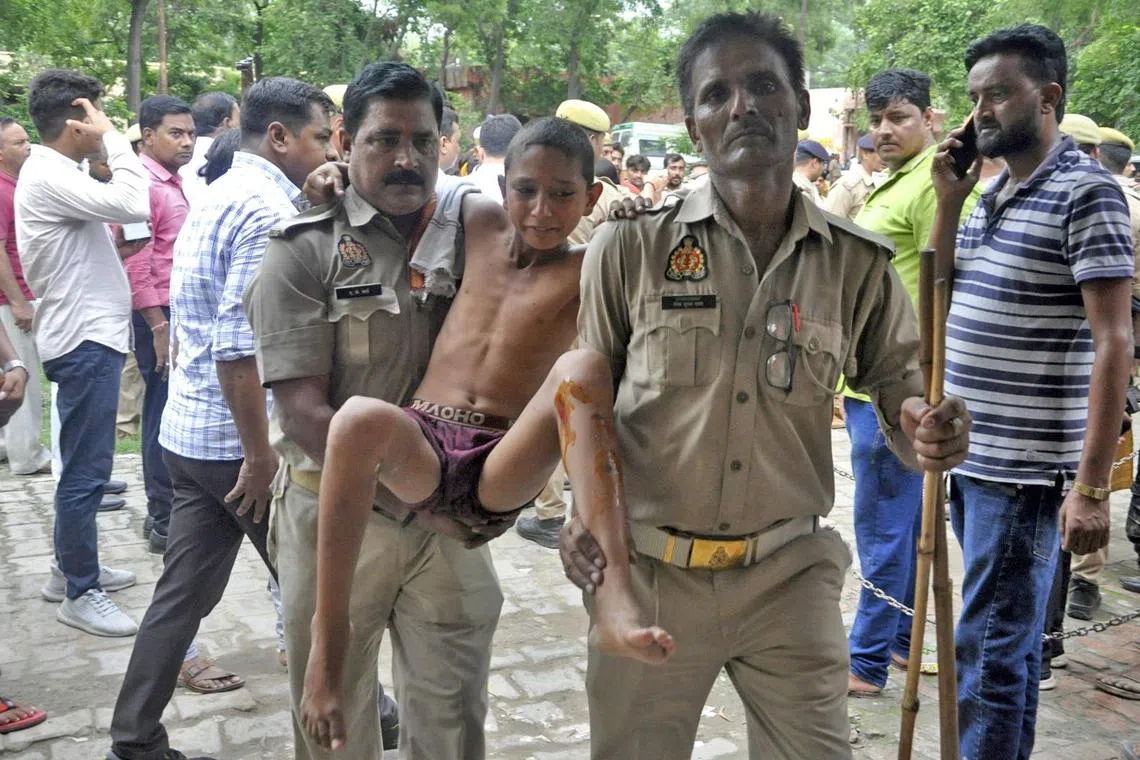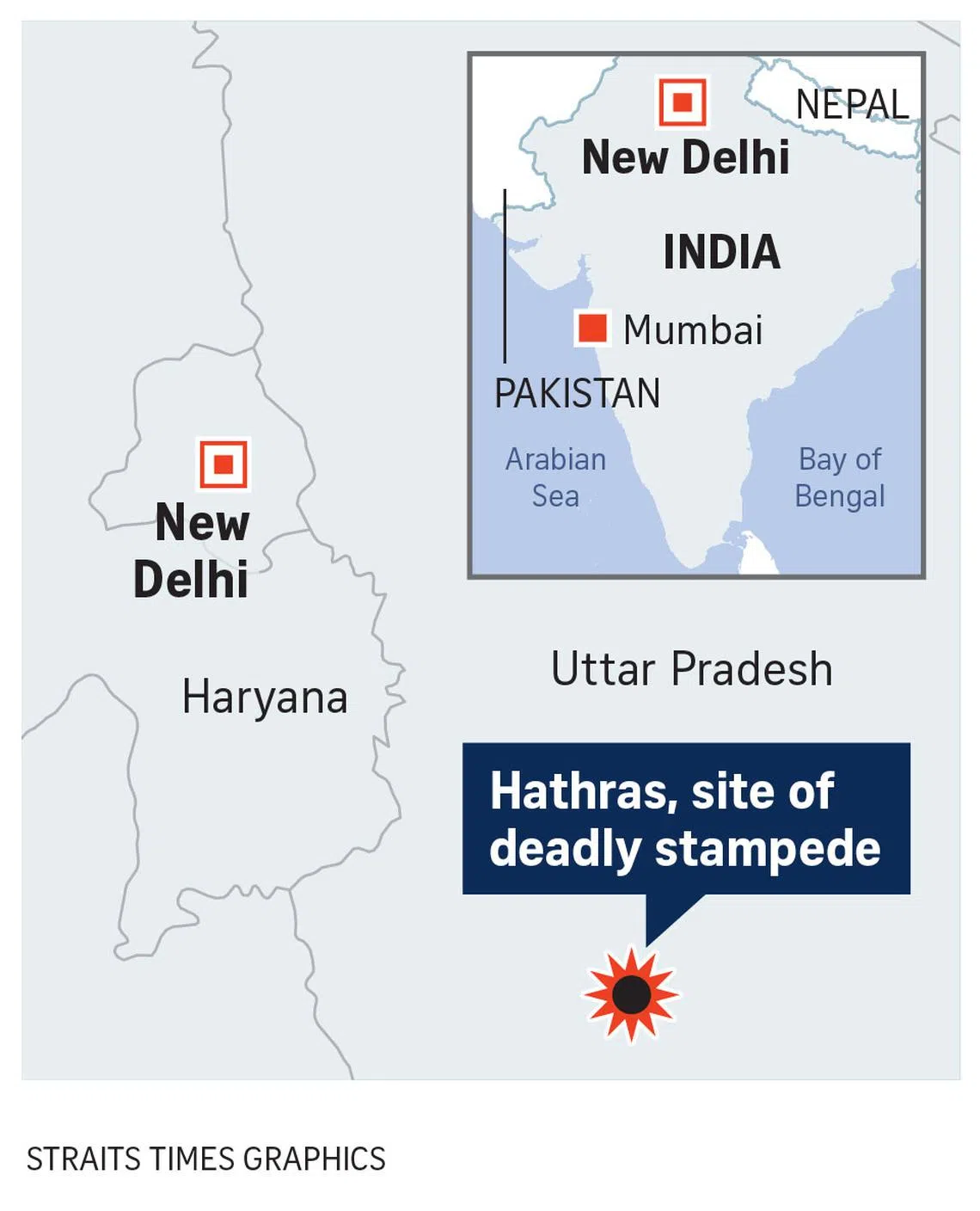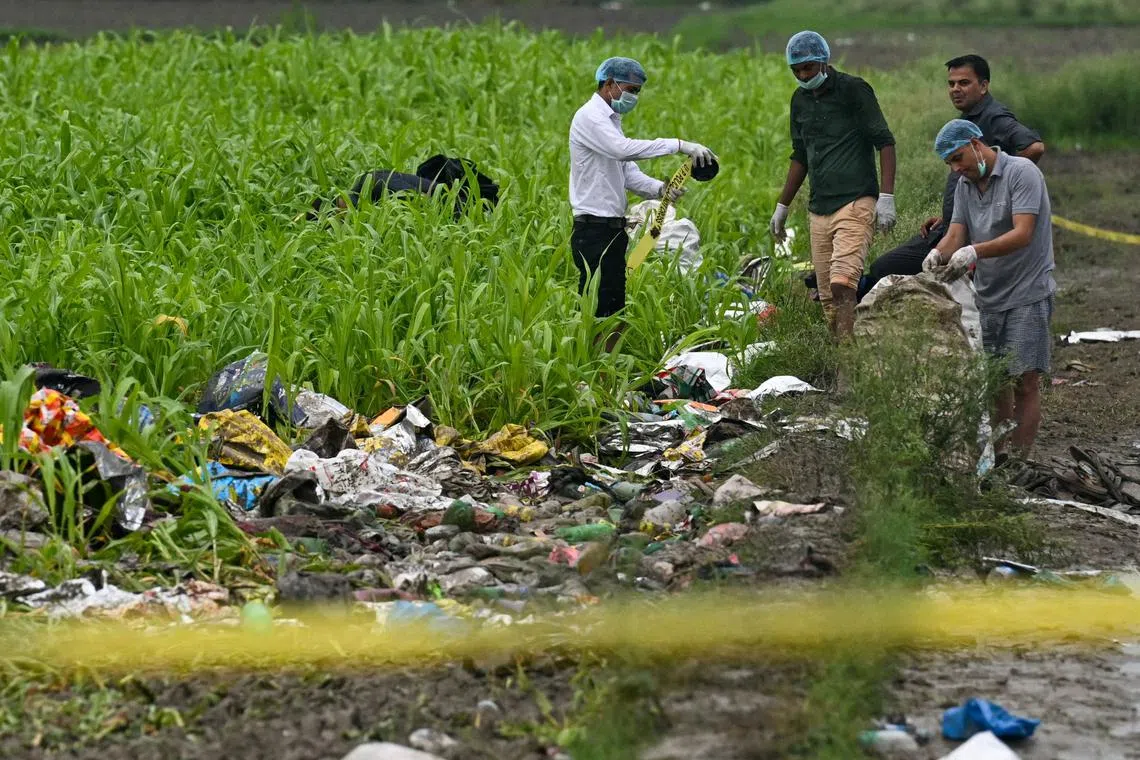Stampede killing 121 at India religious event blamed on overcrowding and mismanagement
Sign up now: Get insights on Asia's fast-moving developments
Follow topic:
HATHRAS, India - The only signs left of a deadly stampede that occurred in northern India on July 2 were the flip-flops and sandals strewn across the venue and adjoining road.
Rain had washed away almost everything else of the chaos that had killed 121 people attending a prayer meeting in Hathras
While organisers had permission from the local authorities to accommodate 80,000 people for the hour-long religious meeting, about 250,000 devotees turned up at the venue, a padi field in Phulrai village next to a highway.
The stampede occurred when people rushed to get a glimpse of the flamboyant guru, popularly known as Bhole Baba, as he left the event.
Overcrowding, combined with poor crowd management, led to the high death toll, officials said. Hathras is in Uttar Pradesh state, about 170km south-east of India’s capital, New Delhi.
Crowd management remains a challenge amid lax implementation of safety requirements, said disaster management experts, who noted it was contingent on the organisers to ensure the safety of those attending religious events.
They also pointed to lapses by police and the local authorities.
“Any mass gathering has to have police permission. They should have ensured how many people were coming.
“And the police, before giving permission, should ensure planning has been done,” said retired colonel V.N Supankar, a disaster management consultant who has helped draft plans for the Kumbh Mela, a Hindu festival typically attended by millions of devotees.
“You cannot (completely) prevent any such incident, but due precautions should be taken. Such eventualities take place, and there will be losses. But if you are prepared, the losses will be (at a) minimum. It won’t be 121.”
Amid criticism that the local authorities and the police did not implement safety measures, the state government ordered a judicial inquiry and registered a police case against the organisers of the event for culpable homicide not amounting to murder, along with other charges. The charge of culpable homicide carries the maximum penalty of a life sentence.
“This will not happen again. We will put in standard operating procedures and ensure they are followed,” said Uttar Pradesh Chief Minister Yogi Adityanath, who is from the Bharatiya Janata Party and is facing criticism from opposition politicians for the tragedy.
“The culprits will not be spared.”

A boy, who was injured in a stampede at a religious gathering, brought to a hospital for a treatment in Hathras district in the northern state of Uttar Pradesh, India, on July 2, 2024.
PHOTO: REUTERS
Police, witnesses and local officials painted a picture of mayhem on July 2 as people, mainly women, ran after Bhole Baba as he was leaving the venue to get a glimpse of him.
Bhole Baba, a former police constable, has a sizeable following, particularly among women, in parts of Uttar Pradesh and other neighbouring areas.
Many were also looking to pick up the dust on which he walked to put on their foreheads as a sign of devotion, tripping up the people behind them.
Others were crushed as they tried to get away, falling over each other into a depression between the padi field and the elevated highway, according to local villagers and victims.
Officials said that volunteers and security officers also exacerbated the situation by pushing the crowd away from the guru, who left the venue. While police officers were reportedly present to manage the crowds, it was unclear how many there were. Some were also injured in the stampede.
In a statement, Bhole Baba expressed condolences to the victims and their families, but said “the stampede was created by some anti-social elements”. No charges have been filed against the guru yet.

India is the world’s most populous country with 1.4 billion people and a Hindu-majority population. It has had stampedes in the past.
In 2022, 12 people were killed and 15 injured in Kashmir during a crowd crush at the Mata Vaishno Devi shrine, where tens of thousands of Hindus had gathered to pay respects.
In 2008, around 168 people were killed in a stampede at a temple in Jodhpur in Rajasthan state, where people had gathered to celebrate a Hindu festival.
Among those pinned down in Tuesday’s crush was 75-year-old Maya Devi, an ardent follower of Bhole Baba.
“I fell down, and then a woman fell on top of me. I couldn’t move, and I felt like I couldn’t breathe,” Mrs Devi said from her hospital bed, 35km from the venue.

Forensic experts inspect the stampede site that killed people during a sermon at Hathras in India’s Uttar Pradesh state, on July 3, 2024.
PHOTO: AFP
Many of the victims were taken to other hospitals in the vicinity as the hospital in Hathras did not have the capacity for more patients.
Her daughter Gomwati, who is not a follower of Bhole Baba, considers her mother lucky. Two of Mrs Devi’s friends were killed in the stampede.
“We told her not to go, but she went anyway. We were worried because she is elderly and there are large crowds at these events,” said Ms Gomwati, who was sitting at her mother’s bedside.
To her relief, an X-ray ruled out any broken bones for Mrs Devi.
Victims and their families were divided on who to blame.
But Mr Roop Singh, whose 50-year-old mother and two-year-old nephew suffered fractures, said: “I hold the baba responsible.”
His mother had wrapped herself around her two-year-old grandson to prevent him from getting hurt.
“My mother and nephew escaped with their lives. I am thankful for that.”


